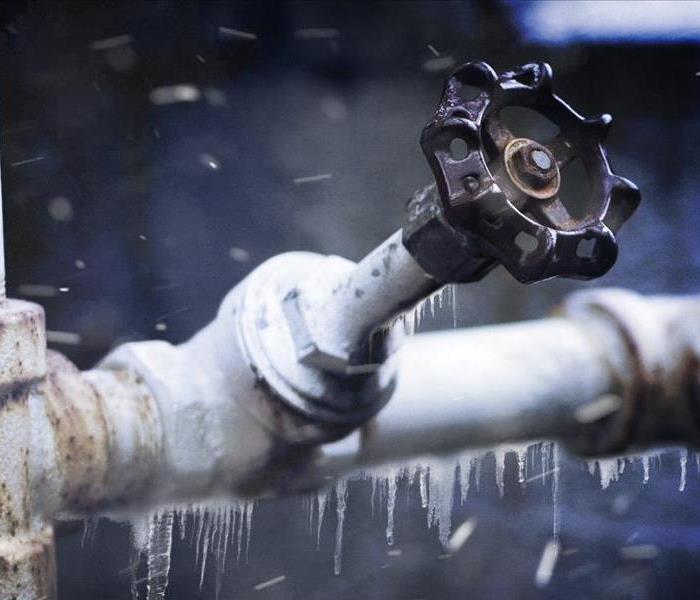Recent Water Damage Posts
Icicles Means You Have Ice Dams!
2/11/2020 (Permalink)
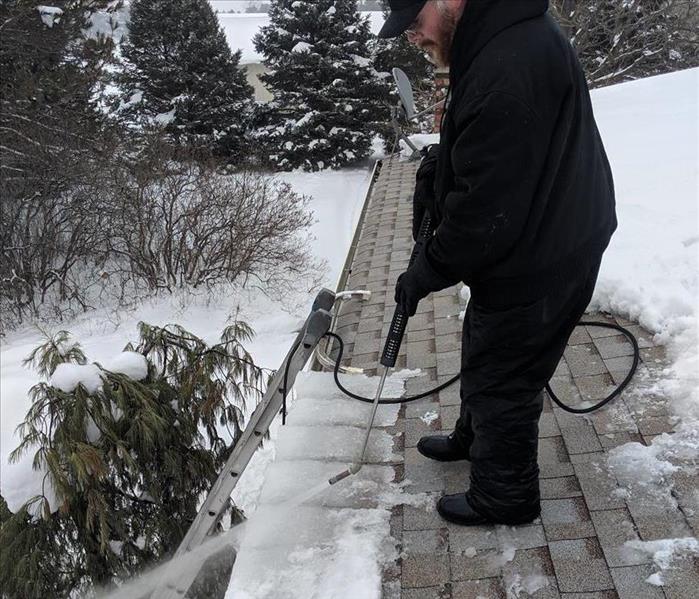 Removing ice dams and cleaning up the associated mess inside is what SERVPRO is all about!
Removing ice dams and cleaning up the associated mess inside is what SERVPRO is all about!
If you have Icicles, you have ice dams!
Q: Why do ice dams form?
A: When your roof vents are overrun with snow, the vents do not allow warm air from the attic to escape. The heat builds up in your attic. Since the heat has nowhere to go, your roof deck heats up and melts the snow pack at the roof surface.
The melted snow runs down your (warm) roof and turns to ice on the unheated eaves. This ice pack builds and builds until it backs up under your shingles...once it gets backed up past the place the exterior walls meet the roof, the warm roof deck melts the ice from underneath and the result is "loose" water that penetrates the roof deck and works its way down the roof line (inside the attic) to your exterior walls.
Take a look outside. If you see ice working its way between siding and window joints, you already have water in your wall cavities! Your insulation is wet, the framing is wet, and the wall sheathing is wet.
Sitting in your walls behind the vapor barrier, this moisture cycles between freezing, evaporating, and condensing, a situation that is ideal for mold growth! If left unchecked, you can have a widespread mold problem and not know it.
Q: So, what to do about ice dams?
(1) Make sure your roof vents are cleared regularly. Just one big snow fall can clog them. Especially ridge vents.
(2) Shovel the roof to make sure the eaves are cleared 6-8' back from the edge.
(3) If you do get ice dams, call SERVPRO to have them removed with gentle steam. Do NOT try to break them up with a hammer or use salt. This can cause damage to your roofing materials.
(4) If you see water dripping through a ceiling or wall, the good news is interior water damage from ice dams is generally covered by insurance. Check with your agent to verify coverage and file a claim. Call SERVPRO of the Twin Ports (218) 727-2575 immediately to remove the ice dams from the roof then address affected walls and insulation, get the interior sheathing and framing dry, and replace the interior insulation, vapor barrier, and wall materials, repaint, re-trim etc.
SERVPRO is here to make your ice dam event "Like it never even happened."
Sometimes roof repairs or insulation removal in the attic may be necessary to correct water intrusion problems.
If you have any of these issues right now, please send us photos and give us a call for a free immediate consultation by phone.
email: k_buck@SERVPROtwinports.com.
Phone: (218) 464-8315
Ice dams and the damage they cause can be a difficult challenge to solve, but our crews at SERVPRO of the Twin Ports are standing by ready to help!
Why Pipes Freeze and Burst in the Winter
1/22/2019 (Permalink)
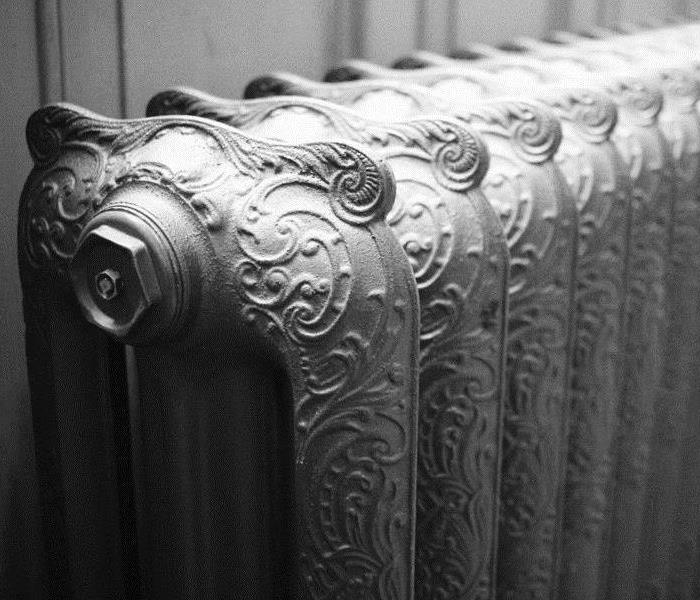 Cast iron radiators were commonly found in homes and buildings built prior to the 1950s.
Cast iron radiators were commonly found in homes and buildings built prior to the 1950s.
There are several types of water pipes in a typical home or commercial establishment. Newer homes built within the past 20 years are more likely to have plastic freshwater supply lines. The plastic material is moderately resistant to freezing, but once it does freeze, it bursts easily. Copper water supply lines were commonly used in the mid-twentieth century and are still frequently found in homes and businesses. These supply lines are setup with either 1/2 inch or 3/4 inch piping. The smaller the piping, the quicker it freezes.
The OLDER homes in the area, pre-1900 to about 1950, have cast iron pipes. If you have an older home with a boiler heating system, you have radiators like the ones pictured. These radiators are supplied with hot water through cast iron piping that circles the perimeter of the house. If the boiler ever fails, these pipes are vulnerable to freezing. One remedy for this is the injection of glycol antifreeze into the system. Check your system to make sure it is adequately protected.
When pipes get cold, ice crystals can form inside the pipes, causing them to force a water blockage. If the pipes freeze solid, also known as a “hard” freeze, the ice crystals will expand inside the pipe, causing a split or rupture. It doesn't matter what kind of piping it is, if the water freezes completely inside the piping, it WILL burst.
When the water supply is on, it is pressurized (which is why water comes out when you turn on a faucet.) Once a pipe bursts, water will gush out, causing damage to walls, insulation, flooring, and valuable personal property. For every minute water is running through a fresh water pipe, it will spew out 3-5 gallons of water. That is about 200 gallons an hour! You can see how little time it takes water to do a tremendous amount of damage to your property.
If you do discover frozen pipes before a burst has occurred take the following precautions.
- Turn the water supply OFF. It is usually a lever or knob coming up from a water supply pipe coming up into your home.
- Turn your furnace up to 75 degrees.
- Open all faucet valves, hot and cold.
- Put fans around the house to circulate warm air, directing the warm air into areas where the piping may be frozen.
- If necessary, place space heaters in the frozen areas.
Turn on the water supply briefly for a few minutes - enough time to check the faucets to see if they are running. If not, turn off the water supply and try again once an hour.
If you have a burst pipe, do NOT leave the water on. Call SERVPRO of The Twin Ports to get immediate assistance in dealing with the residual moisture.
If you see water where it should not be, it IS an emergency situation. SERVPRO of The Twin Ports is available 24 hours a day, 7 days a week to respond to any emergency in the Duluth-Superior area.
5 Ways to Fix and Prevent Frozen Pipes
1/10/2019 (Permalink)
Bitterly cold temperatures wreaked havoc on much of the country last week. Unfortunately, not everyone made it through without experiencing frozen pipes—us included!
Here are 5 things that we’ve learned about fixing and preventing frozen pipes:
Pipes don’t always freeze in the same spot. Just because a particular pipe hasn’t been prone to freezing in the past doesn’t mean that it won’t freeze this year, particularly after a week of sustained cold.
A hairdryer doesn’t always do the trick. It’s a good starting point, but sometimes pipes are simply too frozen for this strategy to be effective.
The biggest challenge is when pipes freeze behind a wall. Unlike exposed pipes, pipes that freeze behind a wall are difficult to treat. Try cranking the heat to warm the room. Otherwise, unless you want to start poking holes in the wall, you’ll probably need to call a plumber.
A plumber with a thaw machine will be your savior. A thaw machine shoots electricity through frozen pipes to melt blockages in minutes—and many plumbers have them.
Running the water will keep pipes from re-freezing. This isn’t just an old wives’ tale! Letting faucets drip during cold spells is the only effective way to prevent pipes from freezing.
ELECTRONICS RESTORATION
3/18/2016 (Permalink)
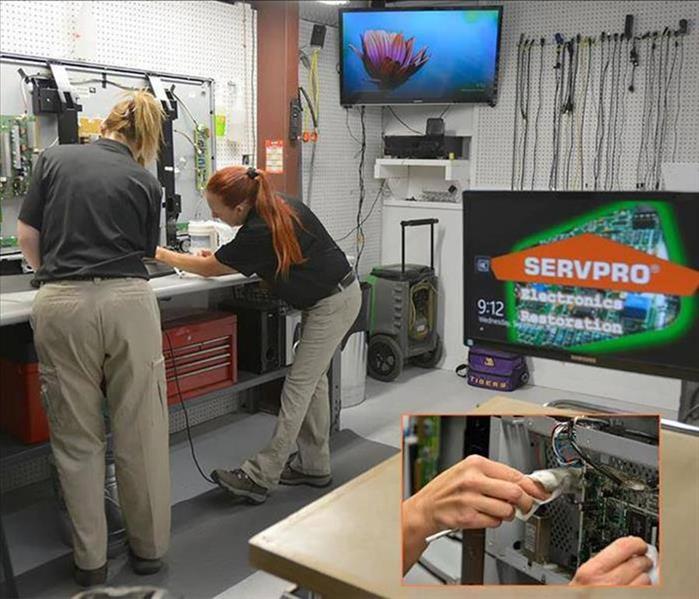 Computers, televisions, stereo equipment, DVD players, computer routers, oscilloscopes, electrical meters, flat bed scanners and industrial electronic
Computers, televisions, stereo equipment, DVD players, computer routers, oscilloscopes, electrical meters, flat bed scanners and industrial electronic
SERVPRO of the Twin Ports utilizes the Omegasonics 2300E® Electronic Cleaning Station effectively and safely restores sensitive electronics, including computers, televisions, stereo equipment, DVD players, computer routers, oscilloscopes, electrical meters, flat bed scanners and industrial electronics, removing all fire damage contaminants without saturating the items in water. Once cleaned, items are placed into the Omegasonics 6500E® Electronic Drying Chamber, a state-of-the-art system that thoroughly dries and deodorizes electronics using a low-temperature, high-volume updraft drying design.
Winter Ice Dams: Cause, Effects, and Prevention
2/5/2016 (Permalink)
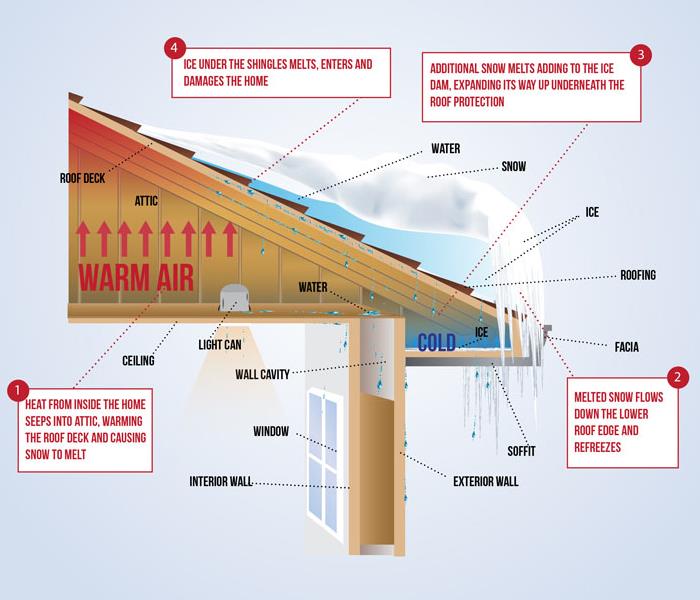 What Causes Ice Dams?
What Causes Ice Dams?
What Causes Ice Dams?
Ice dams form when melting ice and snow refreeze above the eaves of your roof and subsequent melting backs up under the shingles. This causes interior leaks and water damage to interior walls and ceilings.
Preventing Ice Dams
Proper ventilation, drainage, clearing of leaves and debris
- Check and seal places where warm air could leak from your house to the attic: vent pipes, exhaust fans, chimneys, attic hatches and light fixtures are all possibilities
- Inspect, or have your roof and attic inspected for proper ventilation and insulation
- Look for signs of inadequate ventilation: rust spots, rusty nails or a mildew smell are all signals that moisture has formed on the inside of your roof
- If you have soffit vents in your eaves, make sure they are not blocked and insulation surrounding them is secured so that air can flow easily
- Keep snow from accumulating on the lower three to six feet of your roof
Additional Steps
- Install snow and ice slides to prevent ice and snow from "bonding" to the lower roof
- Install a rubberized ice and water shield beneath the roof shingles for the first three to six feet from the eaves up
- Install heating cable along the eaves to melt ice
Removing Ice Dams
- Consult a roofing professional
- Do not use a snow blower, shovel or blowtorch to try to chip, break or melt ice dams
Although SERVPRO of The Twin Ports does not have the proper equipment to remove ice dams, we do know how to dry out the interior structure if ice dams have caused internal water damage.
Contact us at (218) 727-2575 for more information.





 24/7 Emergency Service
24/7 Emergency Service


